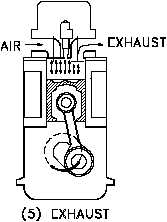DOE-HDBK-1018/1-93
Diesel Engine Fundamentals
FUNDAMENTALS OF THE DIESEL CYCLE
to useful work, 28% heat rejected to the cooling system, and 30% heat rejected
out the exhaust.
Exhaust
Figure 20 Exhaust
As the piston approaches 48 BBDC, the cam of the
exhaust lobe starts to force the follower upward, causing
the exhaust valve to lift off its seat.
As shown in
Figure 20, the exhaust gasses start to flow out the exhaust
valve due to cylinder pressure and into the exhaust
manifold. After passing BDC, the piston moves upward
and accelerates to its maximum speed at 63 BTDC. From
this point on the piston is decelerating. As the piston
speed slows down, the velocity of the gasses flowing out
of the cylinder creates a pressure slightly lower than
atmospheric pressure. At 28 BTDC, the intake valve
opens and the cycle starts again.
The Two-Stroke Cycle
Like the four-stroke engine, the two-stroke engine must go
through the same four events: intake, compression, power, and exhaust. But a two-stroke engine
requires only two strokes of the piston to complete one full cycle. Therefore, it requires only one
rotation of the crankshaft to complete a cycle. This means several events must occur during each
stroke for all four events to be completed in two strokes, as opposed to the four-stroke engine
where each stroke basically contains one event.
In a two-stroke engine the camshaft is geared so that it rotates at the same speed as the
crankshaft (1:1). The following section will describe a two-stroke, supercharged, diesel engine
having intake ports and exhaust valves with a 3.5-inch bore and 4-inch stroke with a 16:1
compression ratio, as it passes through one complete cycle. We will start on the exhaust stroke.
All the timing marks given are generic and will vary from engine to engine.
Exhaust and Intake
At 82 ATDC, with the piston near the end of its power stroke, the exhaust cam begins
to lift the exhaust valves follower. The valve lash is taken up, and 9 later (91 ATDC),
the rocker arm forces the exhaust valve off its seat. The exhaust gasses start to escape
into the exhaust manifold, as shown in Figure 21. Cylinder pressure starts to decrease.
After the piston travels three-quarters of its (down) stroke, or 132 ATDC of crankshaft
rotation, the piston starts to uncover the inlet ports. As the exhaust valve is still open, the
uncovering of the inlet ports lets the compressed fresh air enter the cylinder and helps
cool the cylinder and scavenge the cylinder of the remaining exhaust gasses (Figure 22).
Commonly, intake and exhaust occur over approximately 96 of crankshaft rotation.
Rev. 0
ME-01
Page 25

